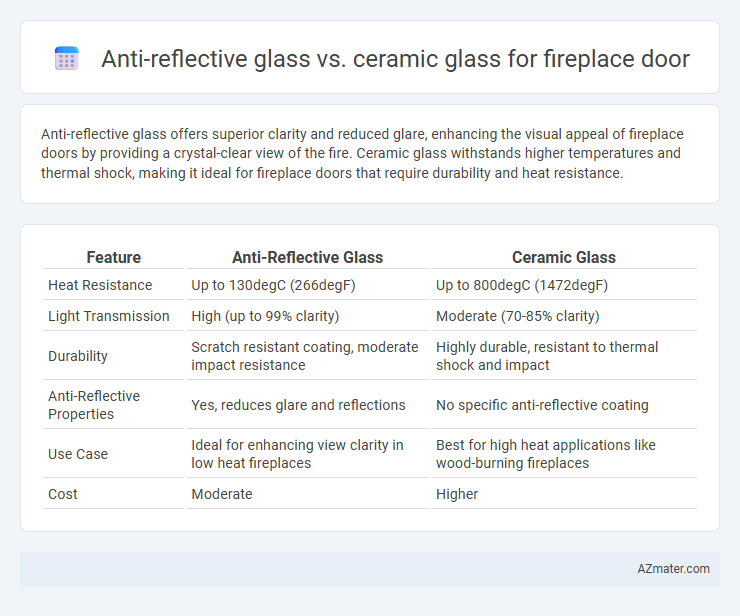Anti-reflective glass offers superior clarity and reduced glare, enhancing the visual appeal of fireplace doors by providing a crystal-clear view of the fire. Ceramic glass withstands higher temperatures and thermal shock, making it ideal for fireplace doors that require durability and heat resistance.
Table of Comparison
| Feature | Anti-Reflective Glass | Ceramic Glass |
|---|---|---|
| Heat Resistance | Up to 130degC (266degF) | Up to 800degC (1472degF) |
| Light Transmission | High (up to 99% clarity) | Moderate (70-85% clarity) |
| Durability | Scratch resistant coating, moderate impact resistance | Highly durable, resistant to thermal shock and impact |
| Anti-Reflective Properties | Yes, reduces glare and reflections | No specific anti-reflective coating |
| Use Case | Ideal for enhancing view clarity in low heat fireplaces | Best for high heat applications like wood-burning fireplaces |
| Cost | Moderate | Higher |
Introduction to Fireplace Door Materials
Fireplace doors commonly utilize anti-reflective glass or ceramic glass, each offering distinct advantages based on thermal resistance and clarity. Anti-reflective glass enhances visibility by minimizing glare and reflections, providing a clear view of the fire while maintaining moderate heat tolerance. Ceramic glass withstands higher temperatures up to 1400degF, ensuring safety and durability in high-heat environments but with less optical clarity compared to anti-reflective glass.
What is Anti-Reflective Glass?
Anti-reflective glass for fireplace doors is specially coated to reduce glare and reflections, enhancing visibility of the fire while maintaining safety and heat resistance. This glass improves the viewing experience by allowing more light to pass through, unlike ceramic glass which prioritizes high heat tolerance but typically has a reflective surface. Anti-reflective glass balances clarity and performance, making it ideal for aesthetic fire features where optimal visibility is desired.
Understanding Ceramic Glass for Fireplaces
Ceramic glass for fireplace doors offers superior heat resistance, withstanding temperatures up to 1,200degC (2,192degF), making it ideal for wood-burning and high-temperature fireplaces. Unlike anti-reflective glass, ceramic glass provides exceptional durability and thermal shock resistance, preventing cracks and ensuring safety during rapid temperature changes. Its ability to maintain clarity under extreme heat enhances viewing pleasure while protecting against heat loss and minimizing hazardous emissions.
Heat Resistance: Anti-Reflective vs Ceramic Glass
Ceramic glass offers superior heat resistance compared to anti-reflective glass, withstanding temperatures up to 1,260degC (2,300degF) without deformation or discoloration. Anti-reflective glass, typically designed for optical clarity rather than heat endurance, generally tolerates maximum temperatures around 200degC (392degF), making it less suitable for high-heat applications like fireplace doors. Choosing ceramic glass ensures durability and safety under intense thermal conditions.
Clarity and Viewing Experience
Anti-reflective glass for fireplace doors significantly enhances clarity by minimizing glare and reflections, providing an unobstructed, crystal-clear view of the flames. Ceramic glass, while highly durable and resistant to extreme heat, typically offers less optical clarity due to its thicker composition and slight tinting. Choosing anti-reflective glass prioritizes an immersive viewing experience, whereas ceramic glass emphasizes heat resistance with some trade-offs in visual sharpness.
Safety and Durability Comparison
Anti-reflective glass for fireplace doors enhances visibility by reducing glare while maintaining high heat resistance, offering strong protection against thermal stress and impact. Ceramic glass withstands extreme temperatures reaching up to 1400degF, providing superior durability and safety by resisting shattering under intense heat exposure. Both materials ensure safety, but ceramic glass typically offers greater longevity and heat tolerance, making it ideal for high-performance fireplace applications.
Maintenance and Cleaning Requirements
Anti-reflective glass requires minimal cleaning due to its smudge-resistant coating, which helps maintain clear visibility of the fire with less frequent maintenance. Ceramic glass, while highly heat-resistant and durable, often needs more rigorous cleaning to remove soot and residue, as it lacks specialized coatings that reduce grime buildup. Choosing anti-reflective glass can reduce time and effort spent on fireplace door upkeep, whereas ceramic glass demands more regular attention to preserve its transparency.
Cost Differences and Value
Anti-reflective glass for fireplace doors generally costs more due to advanced coatings that reduce glare and improve visibility, enhancing aesthetic appeal and safety. Ceramic glass, while typically more affordable, offers superior heat resistance and durability, making it a practical choice for frequent use and higher temperatures. Evaluating cost differences alongside performance needs ensures optimal value, balancing upfront investment with long-term durability and visual clarity.
Aesthetic Appeal: Choosing the Right Look
Anti-reflective glass offers superior clarity and minimal glare, enhancing the view of flames with a sleek, modern aesthetic ideal for contemporary fireplace designs. Ceramic glass, known for its opaque and smooth finish, provides a more traditional, robust look that complements rustic or classic interiors. Selecting between the two depends on whether the priority is a crystal-clear, unobstructed flame display or a durable surface emphasizing warmth and texture.
Which Glass is Best for Your Fireplace?
Anti-reflective glass offers superior clarity by minimizing glare and reflections, enhancing the view of the fire while maintaining safety with heat-resistant properties. Ceramic glass, known for its high heat tolerance up to 1400degF (760degC), provides excellent durability and thermal shock resistance, ideal for high-temperature fireplaces. For optimal fireplace door performance, ceramic glass is best suited for wood-burning fireplaces with extreme heat, whereas anti-reflective glass suits gas or electric fireplaces where visual clarity is a priority.

Infographic: Anti-reflective glass vs Ceramic glass for Fireplace door
 azmater.com
azmater.com